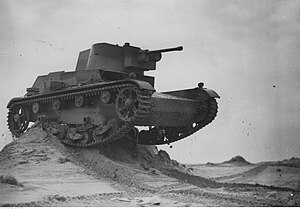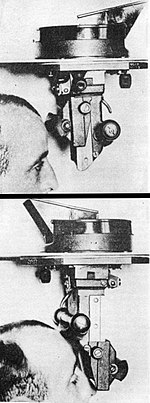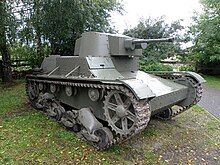7TP
This articleneeds additional citations forverification.(May 2019) |
| 7TP | |
|---|---|
 Single-turret 7TP | |
| Type | Light tank |
| Place of origin | Poland |
| Service history | |
| Used by | Poland Nazi Germany (captured) |
| Wars | World War II |
| Production history | |
| Produced | 1935-1939 |
| No.built | 149 (+13 9TP prototypes) |
| Variants | twin-turret 7TP single-turret 7TP 9TP(prototypes only) |
| Specifications | |
| Mass | 9.9 tonnes |
| Length | 4.6 m (15 ft 1 in) |
| Width | 2.4 m (7 ft 10 in) |
| Height | 2.27 m (7 ft 5 in) |
| Crew | 3 (commander, gunner, driver) |
| Armor | 17 mm maximum |
Main armament | 37 mmBofors wz. 37gun |
Secondary armament | 1× 7.92 mmCkm wz.30machine gun |
| Engine | PZInż.235(Saurer VBLDd) Liquid-cooled inline 6-cylinder 4-stroke direct injection diesel engine 110 hp (80 kW) |
| Power/weight | 11 hp/tonne |
| Suspension | leaf springbogie |
| Ground clearance | 0.38 m |
Operational range | 150 km (93 miles) |
| Maximum speed | 37 km/h (23 mph) |
The7TP(siedmiotonowy polski- 7-tonne Polish) was a Polishlight tankof theSecond World War.It was developed from the BritishVickers 6-ton.A standard tank of thePolish Armyduring the 1939Invasion of Poland,its production did not exceed 150 vehicles. Its chassis was used as the base for theC7Partillery tractor.
Design[edit]

The 7TP was the Polish development of the British Vickers 6-ton Mark E tank licence. Comparing to Vickers, the main new features of 7TP were: a better, more reliable and powerfuldiesel engine,a 37 mmanti-tank gun,thickerarmour(17 mm instead of 13 mm on the front), modified ventilation, theGundlach tank periscope,and a radio. About 132 tanks were produced between 1935 and the outbreak of the war, plus four iron prototypes. The designation 7TP meant "7 Tonne, Polish" (in fact its weight increased to 9 tonnes after the initial prototype).
Although the 7TP is often claimed to be the world's first (production) diesel-powered tank, this distinction actually goes toJapanese Type 89B I-Go Otsu,produced with a diesel engine from 1934 onwards.[1]Barring that, the claim of a first purpose-designed diesel-powered tank is tied withType 95 Ha-Go,whose series production also commenced in 1935.
Like its British predecessor, the 7TP was initially produced in two variants: twinturretversion armed with 2Ckm wz.30machine guns,and a single turret version, armed with 37 mmBofors wz. 37gun. After initial tests, it became clear that the twin-turret variant was obsolete and lacked firepower, so it was abandoned in favour of the more modern single turret design.
Prior to the outbreak of World War II most of the twin turret tanks were converted to single turret versions and only 24 twin-turret types remained in Polish service (as opposed to roughly 108 of the other type). Twin and single turret variants had no specific designations. In some modern books they are unofficially designated "7TP dw." and "7TP jw." (Polish abbreviations fordwuwieżowy– dual turreted;jednowieżowy– single turreted).
In 1938Państwowe Zakłady Inżynieriialso produced 13 prototype models of a better armored version of the 7TP – the9TP.[2][3]Although the 9TP never entered production, these prototypes were used in thedefense of Warsawin September 1939.[4]
Foreign interest[edit]
Romaniasent a military commission in late autumn 1935 to evaluate the 7TP for a future acquisition. Although the tank fared well during field trials, the Romanian officers were not impressed by the armour of the Polish prototype and instead recommended the acquisition of theCzechoslovakLT vz. 35tank.[5]
Combat history[edit]
All 7TP tanks took part in combat in the defence of Poland during the GermanInvasion of Polandin 1939. Most of them were attached to two light tank battalions (the 1st and the 2nd). The remaining tanks, that is the ones used for training as well as tanks that were finished after the outbreak of the war, were used in an improvised tank unit fighting in thedefence of Warsaw.Although technically superior to any of the German light tanks of the era, the 7TP was too scarce to change the outcome of the war.

The 1st Light Tank Battalion (49 single turret tanks) fought in the ranks of thePrusy Armyas part of the strategic reserve force of thePolish Army.It entered combat on September 4, 1939, and fought with distinction in a variety of roles, mostly as a mobile reserve and for covering the withdrawal. It fought in a number of battles, most notably in the battles ofPrzedbórz,Sulejów,Inowłódz,OdrzywółandDrzewica.On September 8 it managed to stop the German advance on the centre of the Polish forces, but the following day it got separated from the main force and had to be withdrawn to the rear. Part of the battalion was destroyed in theBattle of Głowaczów,while the remainder on September 13 managed to break through to the other side of theVistula,where it joined theLublin Armyand Col.Stefan Rowecki'sWarsaw Armoured Motorised Brigade.As part of that unit, the battalion took part in theBattle of Józefówand formed part of the spearhead of the Polish units trying to break through toLwówand theRomanian Bridgehead.After theBattle of Tomaszów Lubelski,on September 21, 1939, the remaining tanks were destroyed by their crews and the unit surrendered to the Germans.

The 2nd Light Tank Battalion (49 single turret tanks) was attached to thePiotrkówOperational Groupof theŁódź Army.It entered combat on September 4 near the river ofPrudka,Bełchatów.The following day it was ordered to lead the Polish counter-assault on Piotrków, but the attack failed because, in spite of retaking some ground from the Germans and destroying German tanks and armored vehicles, the objectives of the mission were not met (the Germans reinforced their positions with artillery). The unit lost 2 tanks and 6 more were taken away disabled. The unit was down to 24 fully operational tanks. The battalion was then rallied and withdrew toWarsawand then toBrześć,where it shielded the mobilization of thePolish 60th Infantry Division.On September 15 it took part in a two-days longBattle of Włodawa,but suffered heavy losses due to air bombardment and was withdrawn southwards. The remaining 11 tanks had to be destroyed by the crews due to lack of oil and on September 17, after the Soviet Union joined Germany in her war against Poland, the crews and the staff of the unit crossed the border withRomania.

The remaining tanks found in Warsaw were formed into the 1st and 2nd Company of Light Tanks by the Command of the Defence of Warsaw. The 1st company had 11 twin-turreted tanks, previously used for training. In the opening stages of theSiege of Warsawthe unit took part in heavy fighting for Warsaw's suburb ofOkęcieand the major airport located there. Due to lack of anti-tank armament, the tanks of the 1st company suffered losses and were withdrawn to the rear on September 12, where the unit was joined with the 2nd company.
The 2nd company had 11 single-turret tanks, as well as an unknown number of other armoured vehicles. It took part in successful defence of the borough ofWolaagainst German infantry and armoured units. It was also used for tactical counterattacks, among others for the village ofWawrzyszew,where the company managed to disrupt enemy preparations for the assault. On September 15 the company was ordered to form a spearhead of the Polish attack aimed at linking up with the forces of thePoznań Armywithdrawing after theBattle of Bzurathrough theKampinosforest north of Warsaw. The attack ended up as a minor success, although the German aerial bombardment caused heavy losses both in personnel and in tanks. The remaining 7TP tanks were used on various sectors of the front until the end of the defence of Warsaw on September 27, when they were destroyed by their crews. At the same time, one 7TP was captured by the Soviets duringtheir invasion of Poland.
The combat experience proved that theBofors wz. 37anti-tank gun used in the 7TP was able to penetrate the armour of any of the German tanks of the time, including the newest, thePanzer IV.On the other hand, the 7TP was too lightly armoured, especially against aerial bombardment.
Reconstruction[edit]

No complete 7TP tanks have survived to this day, although it is planned to build a copy of the tank for theMuseum of the Polish Armyin Warsaw.
A turret gun from a 7TP which was used against the invading Germans in September 1939 and later employed by the Germans in France, is on display in thePolish Institute and Sikorski Museumin London.
A 7TP is being reconstructed inBielsko-Biała,its reconstruction will include many original parts recovered from various places in Poland. It now has an original gearbox and will be soon armed with an original 37mm Bofors gun. The tracks come from a T-26. The reconstructors presented progress of their work at variousreenactors' meetings and historic anniversaries.
Operators[edit]
 Poland- 133 7TP jw, 16 7TP dw, and 13 9TP.
Poland- 133 7TP jw, 16 7TP dw, and 13 9TP. Nazi Germany- 20 7TP jw captured duringGerman invasion of Poland.
Nazi Germany- 20 7TP jw captured duringGerman invasion of Poland.
Evaluation only
 Soviet Union- At least 4 7TP jw captured duringSoviet invasion of Poland,used for testing.[7]
Soviet Union- At least 4 7TP jw captured duringSoviet invasion of Poland,used for testing.[7]
See also[edit]
- T-26,a similar Soviet tank, also based on the Vickers 6-Ton
- Comparison of early World War II tanks
Bibliography[edit]
- (in English)The Encyclopedia of Tanks and Armored Fighting Vehicles - The Comprehensive Guide to Over 900 Armored Fighting Vehicles From 1915 to the Present Day, General Editor: Christopher F. Foss, 2002
- (in English)Tanks of the World, 1915–1945, Peter Chamberlain, Chris Ellis, 1972
- (in Polish)J. Magnuski, "Czołg lekki 7TP" vol.I, Militaria, 1996;
- (in Polish and English)Janusz Magnuski, "7TP vol.II", Militaria (317), Warsaw 2009.
- (in Polish)L. Komuda, "Polski czołg lekki 7TP", TBiU nr 21, 1973;
- (in Polish)A. Jońca, R. Szubański, J. Tarczyński, "Pojazdy Wojska Polskiego 1939", WKŁ, 1990;
- (in Polish)J. Magnuski, "Produkcja czołgów 7TP 1935-39 r.", nTW 12/1996;
- (in Polish)J. Magnuski, "Angielski lekki czołg Vickers Mark E w polskiej służbie", nTW 5/1999;
- (in Polish)R. Szubański, "Polska broń pancerna 1939", wydawnictwo MON, 1982;
References[edit]
- ^Zaloga, Steven(2007).Japanese Tanks 1939—1945.Oxford: Osprey Publishing. p. 5.ISBN978-1-84603-091-8.
- ^A. Jońca, J. Szubański, R. Tarczyński:Wrzesień 1939. Pojazdy Wojska Polskiego. Barwa i broń.,Warszawa: Wydawnictwa Komunikacji i Łączności, 1990, ss. 52-53.ISBN83-206-0847-3.
- ^A. Wszendyrówny, M. Wodejko:Czołg 7TP w dokumentach Centralnego Archiwum wojskowego,w: "Do Broni", nr 1/2009, s. 96.ISSN1732-9450.
- ^A. Jońca, J. Szubański, R. Tarczyński:op. cit.,s. 32.
- ^gen. maior Nestorescu, Valerian,File din trecutul artileriei române moderne,Editura Militară, București, 1972, p. 87
- ^7TP vol.II,Janusz Magnuski, Militaria 317,Warszawa 2009.
- ^Maksim Kołomijec w: Anton Pieczerskij, „Polskij tank TP”, Strategija KM,ISBN5-901266-01-3,s. 59–60.
